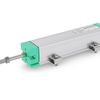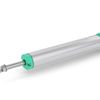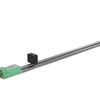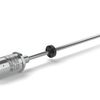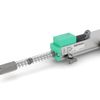Position and pressure transducers for destructive test bench
Learn how to control applied pressure in the destructive test bench
The use of position transducers allows to determine and manage the breaking point of test benches
Test benches are used to certify specific characteristics (e.g. the amount of cement, bitumen, etc.).The management of the breaking point is possible thanks to:
- pressure detection with TPS pressure transducer;
- thickness detection with LT-M or PC-M position sensor;
- detection of the lower plane in rotary benches with potentiometer PY/PZ;
- detection with a PLC for more advanced test benches.
Overview
- Product: LT-M-PC Potentiometric – WPG-WRG Magnetostrictive Position Transducers, TPS Pressure Sensors
- Request: accuracy of <0.1m of position in real time
- Result: Absolute linear position transducers have the accuracy required by the application at a price appropriate to the overall cost of the machine.
The process
In order to ensure that a concrete or asphalt specimen confirms that the building or road surface responds to certain characteristics (e.g. quantity of cement, bitumen, …), it is required for a destructive test bench to determine the breaking point. The test is performed by compressing the specimen up to the break. It is required to monitor and record the values of the applied force and the thickness (tenths of mm) compressed before the final break.
The challenge
In the entry-level versions, the compression force required to crumble the specimen is measured through the applied pressure in bar, by means of a TPS pressure transducer. The LT-M or PC-M position sensors detect the thickness of the specimen and its value at the breaking moment in the test phase. To avoid delays in the signal conversion, no amplification circuits are applied in the sensors.
In the case of a medium-high range destructive bench, magnetostrictive transducers are used, because they have a linearity higher than the potentiometers, load cells are directly positioned above the moving part of the press to detect in real time the breaking moment of the specimen.
In rotating test benches with pusher with an angle different from the base, PY / PZ potentiometers with 25 / 50mm stroke are also used to detect the position of the lower plane.
In the most advanced test benches, always making use of position, force / pressure transducers, the control of the test bench is performed with a PLC. Some recording graphs are available on the Operator station , to meet the specific construction sector regulations. It also allows the operator to load previously predefined positioning and test recipes.
Product benefits
POTENTIOMETERS SENSORS LT/PC/PY/PZ
- Repeatability of linear positioning of 0.1 mm
- Theoretically infinite resolution
- Signal linearity: 0.05% FS
- Real time output signal
MAGNETOSTRICTIVE SENSORS WPG/WRG
- 4… 20mA, 0-10Vdc analog output
- Signal linearity: 0.04% range
- Estimation of theoretically unlimited life
PRESSURE SENSORS TPS
- Non-amplified mV / V output
- Real time output signal
- High accuracy (± 0.15% FSO typical> 200bar / 3000psi)
- Wide range of electrical connectors and process connections
Solution
Potentiometric transducer LT / PC stroke 175-200mm (typical dimensions of the specimens) or magnetostrictive WPG-A or WRG-A for controlling the position of the movable upper half-mold.
HYPERWAVE General series magnetostrictive transducers with 300m stroke.
Pressure transducer of the hydraulic circuit with non-amplified output in mV / V with accuracy of the detected pressure ± 0.15% FSO
Transducer stroke: LT 150-200 mm, aluminum profile
Transducer stroke: PC 150-200 mm, aluminum profile
Transducer stroke: WPG-A 300 mm, aluminum profile
Transducer stroke: WRG-A 300 mm, stainless steel 316 stem
Transducer stroke: PY2 25-50mm, aluminum profile
Transducer stroke: PZ34-S 25-50mm, aluminum profile700 bar TPS mV / V pressure transducer

